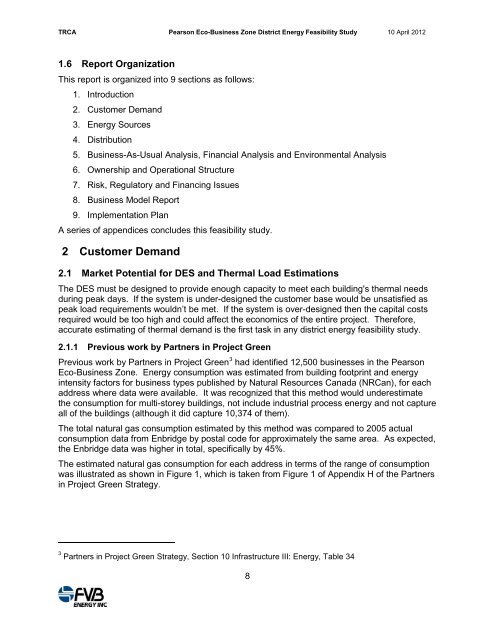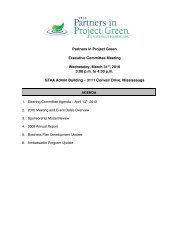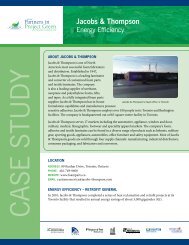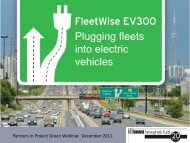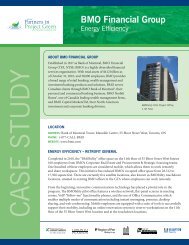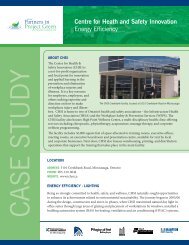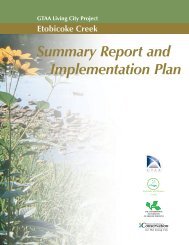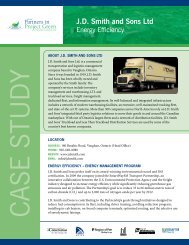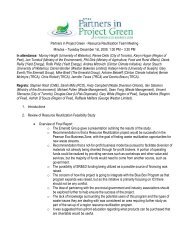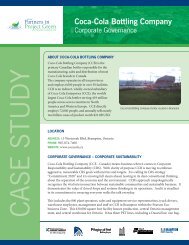Project Green District Energy Feasibility Study - Partners in Project ...
Project Green District Energy Feasibility Study - Partners in Project ...
Project Green District Energy Feasibility Study - Partners in Project ...
You also want an ePaper? Increase the reach of your titles
YUMPU automatically turns print PDFs into web optimized ePapers that Google loves.
TRCA Pearson Eco-Bus<strong>in</strong>ess Zone <strong>District</strong> <strong>Energy</strong> <strong>Feasibility</strong> <strong>Study</strong> 10 April 2012<br />
1.6 Report Organization<br />
This report is organized <strong>in</strong>to 9 sections as follows:<br />
1. Introduction<br />
2. Customer Demand<br />
3. <strong>Energy</strong> Sources<br />
4. Distribution<br />
5. Bus<strong>in</strong>ess-As-Usual Analysis, F<strong>in</strong>ancial Analysis and Environmental Analysis<br />
6. Ownership and Operational Structure<br />
7. Risk, Regulatory and F<strong>in</strong>anc<strong>in</strong>g Issues<br />
8. Bus<strong>in</strong>ess Model Report<br />
9. Implementation Plan<br />
A series of appendices concludes this feasibility study.<br />
2 Customer Demand<br />
2.1 Market Potential for DES and Thermal Load Estimations<br />
The DES must be designed to provide enough capacity to meet each build<strong>in</strong>g's thermal needs<br />
dur<strong>in</strong>g peak days. If the system is under-designed the customer base would be unsatisfied as<br />
peak load requirements wouldn’t be met. If the system is over-designed then the capital costs<br />
required would be too high and could affect the economics of the entire project. Therefore,<br />
accurate estimat<strong>in</strong>g of thermal demand is the first task <strong>in</strong> any district energy feasibility study.<br />
2.1.1 Previous work by <strong>Partners</strong> <strong>in</strong> <strong>Project</strong> <strong>Green</strong><br />
Previous work by <strong>Partners</strong> <strong>in</strong> <strong>Project</strong> <strong>Green</strong> 3<br />
had identified 12,500 bus<strong>in</strong>esses <strong>in</strong> the Pearson<br />
Eco-Bus<strong>in</strong>ess Zone. <strong>Energy</strong> consumption was estimated from build<strong>in</strong>g footpr<strong>in</strong>t and energy<br />
<strong>in</strong>tensity factors for bus<strong>in</strong>ess types published by Natural Resources Canada (NRCan), for each<br />
address where data were available. It was recognized that this method would underestimate<br />
the consumption for multi-storey build<strong>in</strong>gs, not <strong>in</strong>clude <strong>in</strong>dustrial process energy and not capture<br />
all of the build<strong>in</strong>gs (although it did capture 10,374 of them).<br />
The total natural gas consumption estimated by this method was compared to 2005 actual<br />
consumption data from Enbridge by postal code for approximately the same area. As expected,<br />
the Enbridge data was higher <strong>in</strong> total, specifically by 45%.<br />
The estimated natural gas consumption for each address <strong>in</strong> terms of the range of consumption<br />
was illustrated as shown <strong>in</strong> Figure 1, which is taken from Figure 1 of Appendix H of the <strong>Partners</strong><br />
<strong>in</strong> <strong>Project</strong> <strong>Green</strong> Strategy.<br />
3 <strong>Partners</strong> <strong>in</strong> <strong>Project</strong> <strong>Green</strong> Strategy, Section 10 Infrastructure III: <strong>Energy</strong>, Table 34<br />
8


